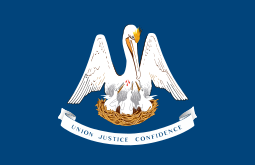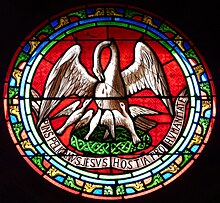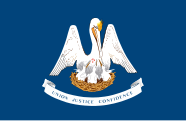 | |
| Other names | Louisiana flag, Pelican flag |
|---|---|
| Use | Civil and state flag |
| Proportion | 13∶20 |
| Adopted | July 1, 1912 (1912-07-01) (modifications in 2006 and 2010) |
| Design | A rectangular field of blue with the arms of Louisiana, the pelican vulning herself, in white in the center, with a ribbon beneath, also in white, containing in blue the state motto, "Union Justice Confidence". |
The flag of Louisiana consists of a rectangular field of blue with the arms of Louisiana, a pelican vulning herself, in white in the center, with a ribbon beneath, also in white, containing in blue the state motto: "Union Justice Confidence". The flag was officially adopted July 1, 1912, and is often referred to as the Pelican flag.
History
As early as 1812, the brown pelican appeared on the Louisiana state seal, various militia company colors, and uniform buttons, including on a flag with a blue field and the phrase "Union, Justice and Confidence".
First flag
On February 11, 1861, the state adopted a flag with a pale yellow star in a red canton and thirteen blue, white, and red stripes. The first flag was used until the end of the Civil War. The flag represented the 13 stripes of the U.S. flag, along with the red, white, and blue of the French tricolor and the yellow and red of the Spanish flag.
|
1912 Flag
In 1878, after the end of Reconstruction in Louisiana, the pre-Civil War flag with a white pelican on a blue field came into common use; however, it was not designated as the state's official flag by an act of the legislature. On June 5, 1912, Rep. William F. Roy of St. Bernard Parish introduced legislation adopting "that flag now in general use" as the state's official flag. The bill was drafted by W. O. Hart of the Louisiana Historical Society, which had endorsed the idea in April 1912. The flag was described at the time as "a solid blue field with the coat of arms of the State, the pelican feeding its young, in white in the center, with a ribbon beneath, also in white, containing in blue the motto of the State, 'Union, justice and confidence'". The bill passed the Louisiana House of Representatives on June 13 by a vote of 71–1. The state Senate followed suit on June 28, approving the measure 32–0. However, beyond stating that the pelican be rendered "in white", the 1912 law did not specify details about the design of the pelican, its number of chicks, or other details, which led to variations in the bird's appearance over the years. Even the shade of blue for the flag varied.
21st-century standardization
During the 19th century, it was traditional on the state flag and seal for the pelican in her piety to have three drops of blood on her chest. In later years, however, the tradition (on both the state flag and seal) was haphazardly followed, which was noticed by an eighth-grader at Vandebilt Catholic High School in Houma, who brought this to the attention of his state legislator.
On May 25, 2006, a law was enacted requiring the flag to include "an appropriate display of three drops of blood" on the pelican's breast; however, it wasn't until November 22, 2010, that a formal redesign of the flag with standardized imagery was formally introduced. Baton Rouge artist Curtis Vann Jr., who was hired to design a standardized pelican for the updated flag, used a more realistic depiction of a brown pelican for his design, although rendered in white as required by law, but he also incorporated the brown pelican's yellow–brown crown. The design also specified an azure field and removed "and" from the banner beneath the pelican's nest.
|
Symbolism

In medieval lore, pelicans were believed to be attentive to the needs of their chicks to the point of drawing their own blood to feed their chicks when no other food was available. This image of the pelican in her piety came to symbolize the Passion of Jesus and the Eucharist.
William C. C. Claiborne, the first governor of the Orleans Territory, selected a pelican for the territory's first seal and it was a common state symbol prior to being formally adopted in 1912 as part of the state flag.
Pledge of allegiance
The Louisiana Pledge of Allegiance, adopted in 1981, is as follows:
"I pledge allegiance to the flag of the state of Louisiana and to the motto for which it stands: A state, under God, united in purpose and ideals, confident that justice shall prevail for all of those abiding here."
See also
- List of flags by design
- List of Louisiana state symbols
- List of U.S. state, district, and territorial insignia
References
- Bonham, Milledge L., Jr. "The Flags of Louisiana." The Louisiana Historical Quarterly 2.1 (1919): 439-446.
- ^ Hart, W. O. (July 1924). "Flag Legislation in Louisiana". The Louisiana Historical Quarterly. 7 (3): 449–454 – via Google Books.
- Madaus, Howard Michael; Legendre, Ken. "Flags of Louisiana". Confederate Flags. Retrieved October 16, 2022.
- "Beveridge and State's Rights". The Times-Democrat. Vol. 44, no. 17856. New Orleans, Louisiana. March 8, 1907. p. 6 – via Newspapers.com.
- "Would Have State Flag". The Times-Democrat. Vol. 49, no. 41369. New Orleans, Louisiana. June 4, 1912. p. 2 – via Newspapers.com.
- "Louisiana's Flag to Be Legalized". The Times-Democrat. Vol. 49, no. 41322. New Orleans, Louisiana. April 18, 1912. p. 13 – via Newspapers.com.
- "House Bills on Final Passage Thursday Night". The Shreveport Journal. Shreveport, Louisiana. June 17, 1912. p. 2. Retrieved April 21, 2024.
- "On Final Passage". The Times-Democrat. Vol. 49, no. 41394. New Orleans, Louisiana. June 29, 2012. p. 7 – via Newspapers.com.
- Whitney Smith, flag of Louisiana at the Encyclopædia Britannica
- ^ Miller, Robin (August 7, 2022). "Is the wrong bird on Louisiana's state flag? Curious Louisiana answers". The Advocate. Baton Rouge, Louisiana. Retrieved October 17, 2022.
- ^ Eagle-eyed eighth-grader prompts La. flag legislation, April 6, 2006 New Orleans Times-Picayune Archived September 30, 2007, at the Wayback Machine
- Act 92. La. St. Legis. 2006.
- Hebert, Dave (June 15, 2006). "Louisiana adds blood drops to state flag". The Daily Reveille. Baton Rouge, Louisiana. Retrieved October 17, 2022.
- "Special Collections hosts talk about Louisiana's new flag". LSU Libraries. November 29, 2010.
- ^ Anderson, Ed (November 3, 2010). "New Louisiana state flag with bleeding pelican is unfurled". The Times–Picayune. New Orleans, Louisiana. Retrieved October 17, 2022.
- Gauding, Madonna (2009). The Signs and Symbols Bible: The Definitive Guide to Mysterious Markings. New York, NY: Sterling Publishing Company. p. 263. ISBN 9781402770043. Retrieved September 20, 2019.
- Cross, F. L.; Livingston, E. A., eds. (2005). "Pelican". The Oxford Dictionary of the Christian Church (3rd ed.). Oxford University Press. ISBN 9780199566716. Retrieved June 6, 2022 – via oxfordreference.com.
- "W.C.C. Claiborne and The State Seal". One Nation Under God: The Church, The State, and the Louisiana Purchase. Baton Rouge, Louisiana: Louisiana State Museum. January 27, 2014. Retrieved October 17, 2022.
- "Louisiana State Pledge of Allegiance". eReferenceDesk. Retrieved April 27, 2018.





